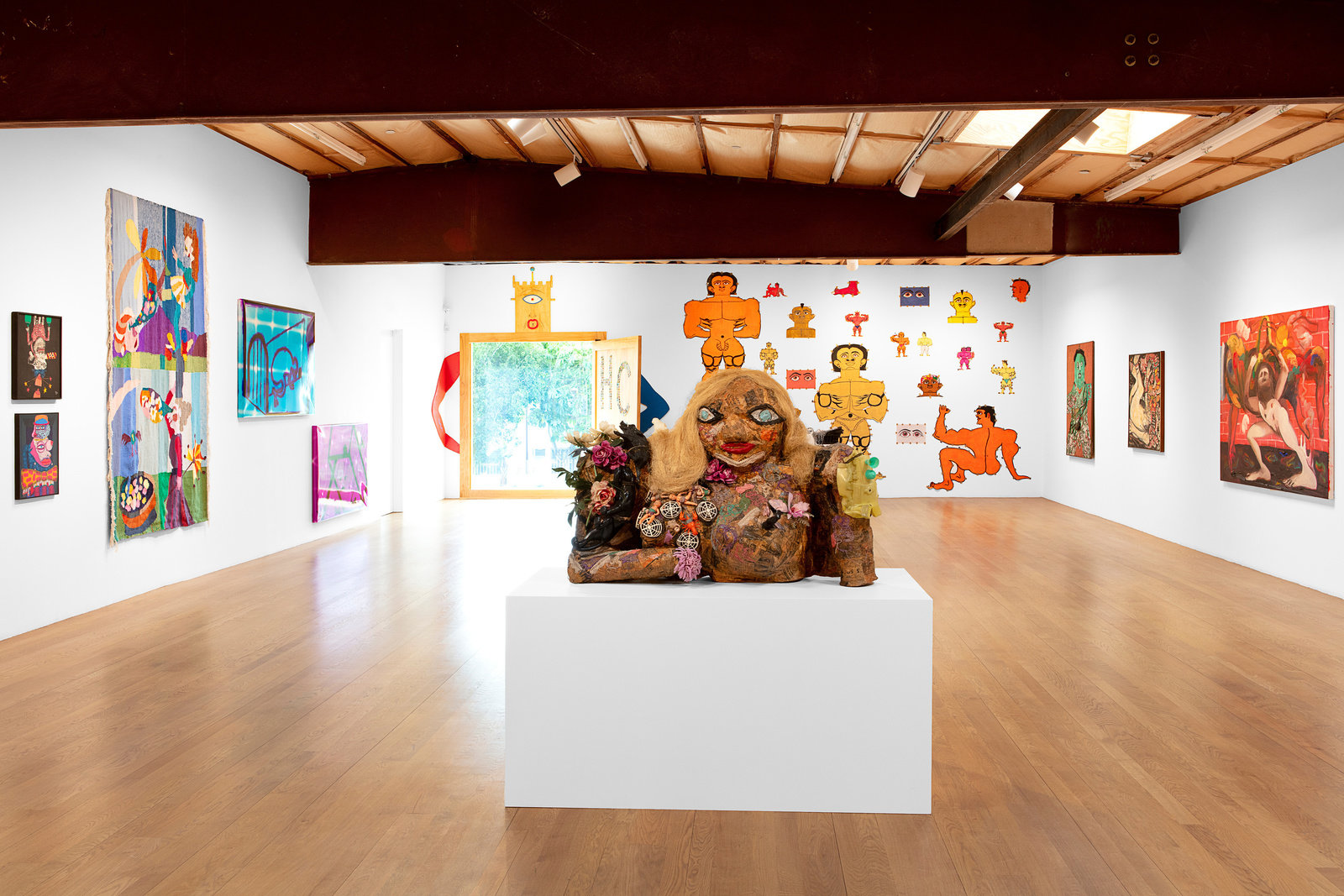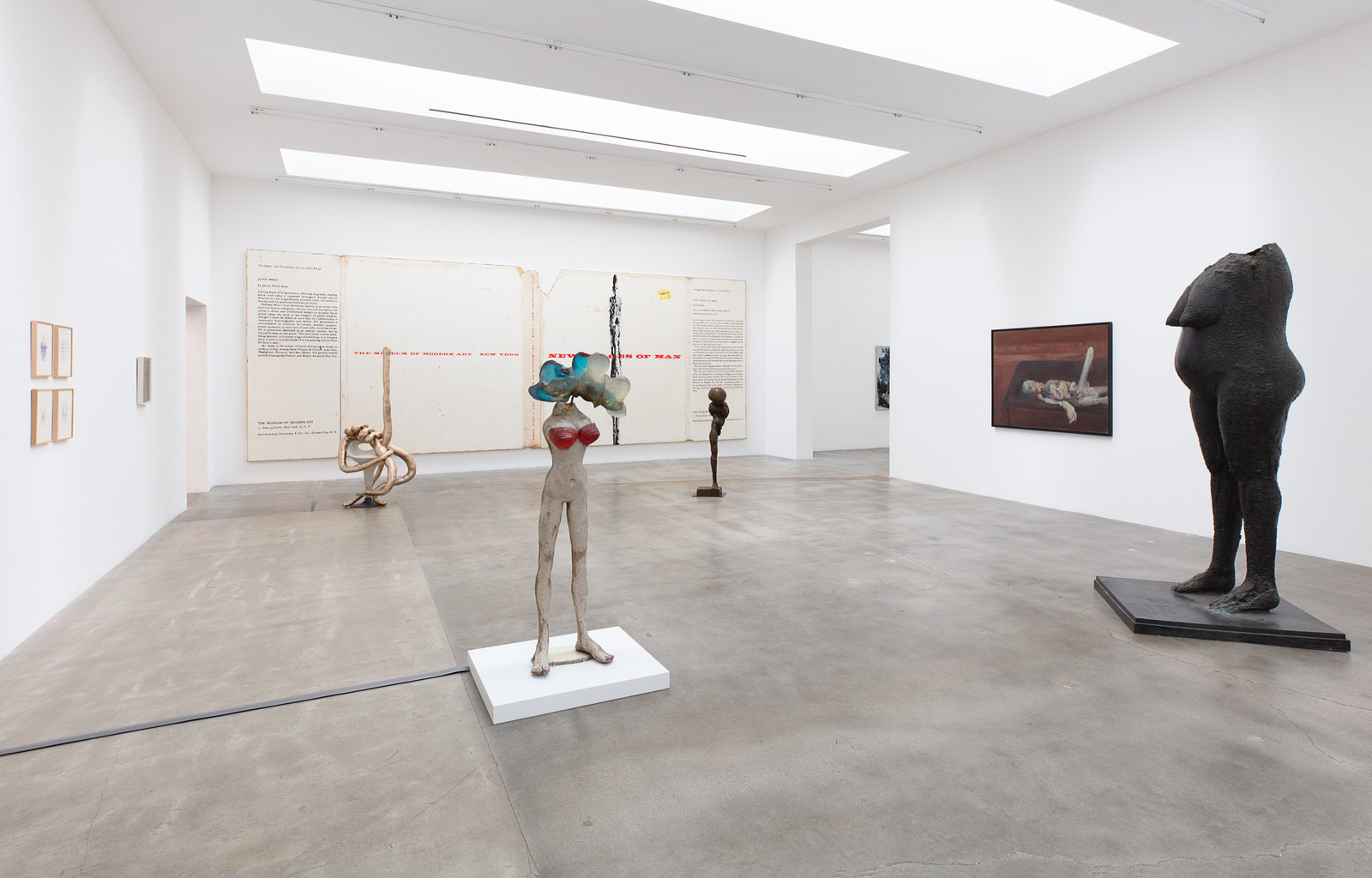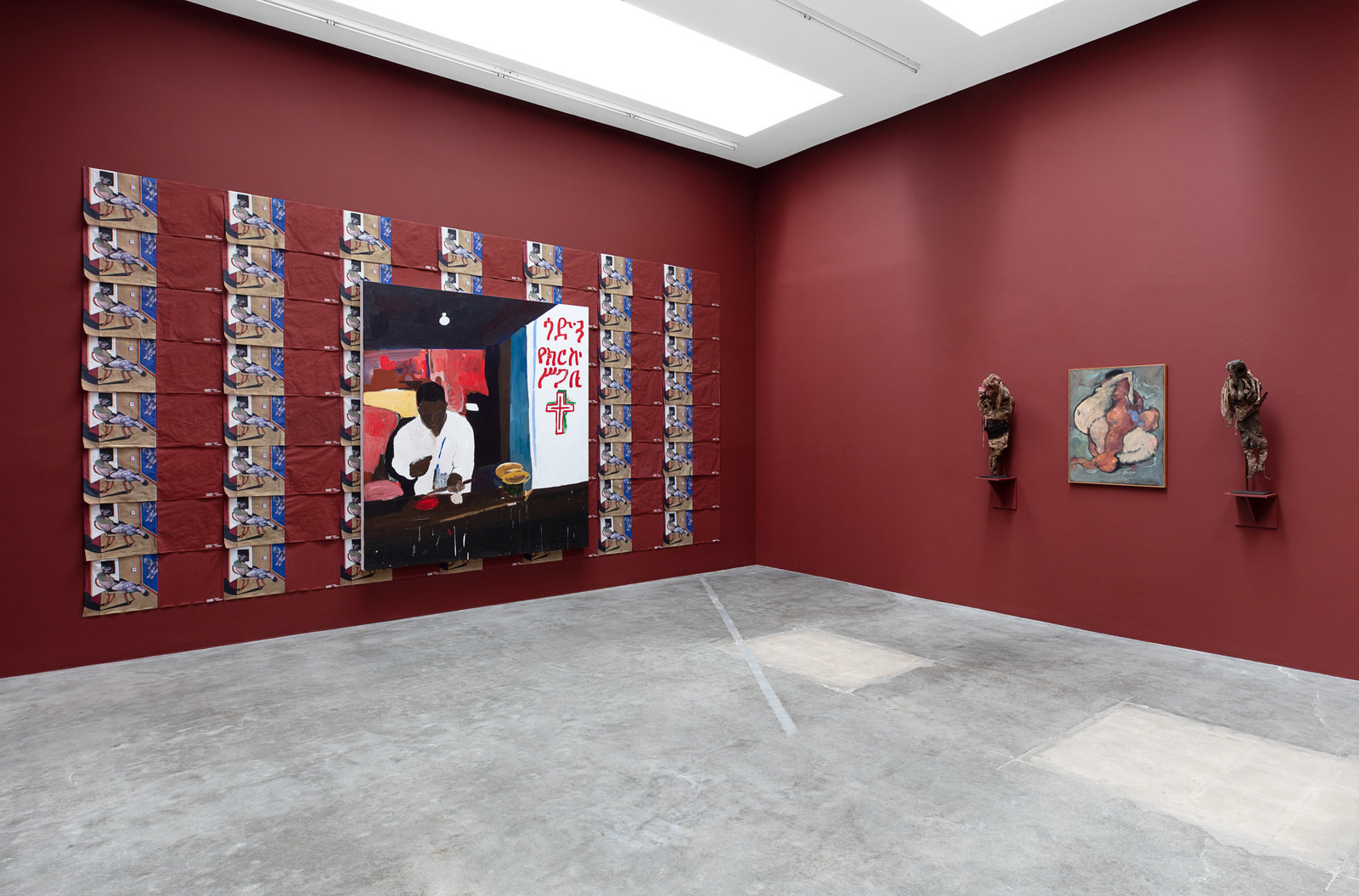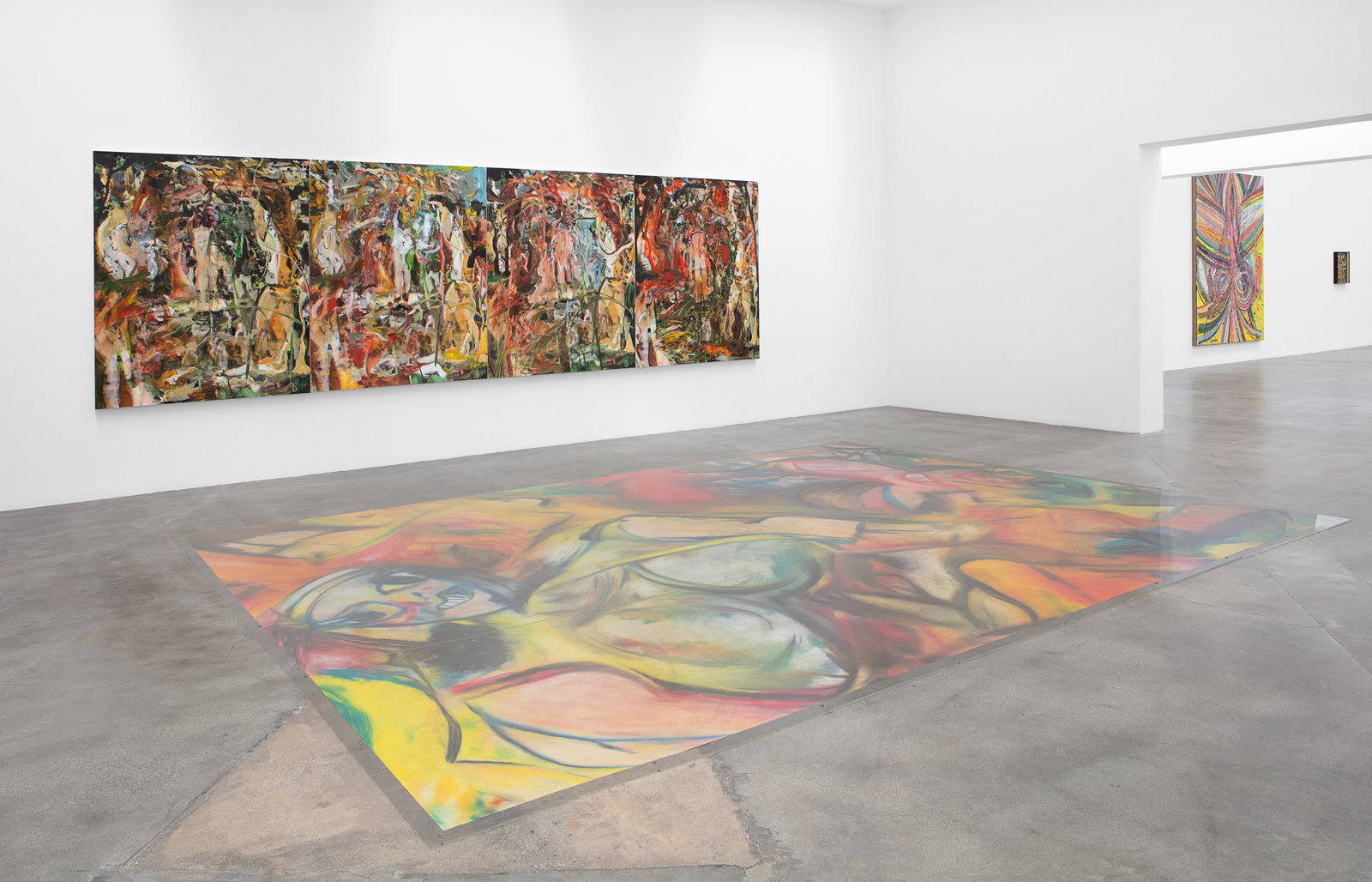Blum & Poe Broadcasts presents free and public access to scholarship and writerly ponderings from our publications archives.
In focus this week—excerpts from the upcoming publication New Images of Man edited by Alison M. Gingeras (Los Angeles: Blum & Poe, 2020).
From this project, Broadcasts features the essay (New) New Images of Man by Alison M. Gingeras.


“El sueño de la razón produce monstruos” —Goya
While I have poured over the pages of the New Images of Man catalogue countless times, it was only recently that its quiet epigraph gave me pause. Peter Selz, the legendary curator at the Museum of Modern Art who emigrated from Germany in 1936 after fleeing Nazi persecution, chose the title of an iconic Goya etching to set a moral tone for his survey of human images in postwar painting and sculpture. Goya’s “The Sleep of Reason Produces Monsters” (1799) is an allegorical self-portrait depicting a slumbering artist hunched over his desk; his irrational dream state unleashes incarnations of dark forces in the form of a swarm of demons, bats, and owls. Deployed as Selz’s opening salvo, the title of this political allegory announces an urgent vision of artistic agency in 1959 when he curated the survey exhibition. When faced with the corrupt forces of society, the artist mustn’t sleep. With this invocation of Goya, New Images of Man advocated for a kind of humanist wokeness.
Selz further makes a case for artists’ ethical responsibility to address the convolutions of the human condition in their works. In his introduction, he explains,
“The revelations and complexities of mid-twentieth-century life have called forth a profound feeling of solitude and anxiety. The imagery of man which has evolved from this reveals sometimes a new dignity, sometimes despair, but always the uniqueness of man as he confronts his fate … these imagists take the human situation, indeed the human predicament rather than formal structure, as their starting point. Existence rather than essence is of the greatest concern to them.” [1]
To address the urgent reexamination of human existence, Selz broke ranks with the hegemonic dominance of Abstract Expressionism to select figurative works by twenty-three artists. Geographically diverse for 1959, Selz showed Western European avant-gardists such as Alberto Giacometti, Jean Dubuffet, César, Francis Bacon, and Karel Appel as the equals of then- ascendant postwar American artists. He did not only showcase works by powerful New York establishment figures such as Willem de Kooning and Jackson Pollock, but also included emergent artists such as Chicago’s H.C. Westermann and Leon Golub, as well as San Francisco’s Richard Diebenkorn. What emerged was a motley snapshot of current art that ruffled the feathers of many critics. Disregarding formal purity or the confines of a cohesive movement, Selz instead selected artists who carried the torch of Goya’s call to socio-political vigilance. With over a hundred works, the artists featured in New Images of Man purported to confront the harrowing fallout of the Second World War while addressing the looming angst of a new global order at midcentury.
The Goya-esque monsters that loomed over this generation’s head included the collective trauma of genocide, the threat of nuclear war, the numbing reach of mass media, simmering ideological struggles between communism and capitalism, and the ravages instigated by centuries of colonial exploitation. In order to put these threats into perspective, MoMA enlisted the humanist philosopher and theologian Paul Tillich to pen a “imagists that take the human situation, indeed the human predicament” preface to the catalogue. Like Selz, Tillich fled from Germany to the US in the 1930s; stripped of his professorship, he experienced firsthand the wrath of the Nazi regime against those who challenged their fascist dictates. Tillich—best known for his accessible writings as well as marrying Christian precepts with existentialism and psychoanalysis—was the perfect ambassador for the universal humanism that was the primary motivation for Selz’s exhibition. While writing in vague terms about art history, Tillich invested in contemporary artists as agents on the frontlines of a moral battleground for the meaning of human existence. He implores,
“Humanity is not something man simply has. He must fight for it anew in every generation, and he may lose his fight. There have been few periods in history in which a catastrophic defeat was more threatening than in ours. One need only look at the dehumanizing structure of the totalitarian systems in one half of the world, and the dehumanizing consequences of technical mass civilization in the other half.” [2]


For the generations that bore witness to the horrors of Auschwitz and Hiroshima, the curatorial impetus for New Images of Man emerged as part of a larger zeitgeist of postwar humanism. Tillich and Selz articulated the collective emotional urgency that drove their need to examine how artists attempted to depict what it meant to be human despite the horrors of sociopolitical failure in the twentieth century.
As such, the existential inquiry implicit in the word “man” mushroomed across the political and cultural landscape. In the desperate attempt to reconstitute the very meaning of man from its Enlightenment origins, the word dominated the titles of popular books, novels, and films that grappled with “humanism under pressure.” [3] In 1948, the United Nations ratified the Declaration of the Rights of Man, stating in its preamble, “Whereas it is essential, if man is not to be compelled to have recourse, as a last resort, to rebellion against tyranny and oppression, that human rights should be protected by the rule of law.” [4] UNESCO organized a series of conferences in 1949 entitled “A New Humanism,” which sought to reconcile the Greco-Roman and Christian Enlightenment roots of Western philosophies with other non-Western religious and philosophical traditions—albeit debated by a pool of mostly white middle-aged men. [5] If This Is a Man was the provocative title of Primo Levi’s harrowing chronicle about surviving the Nazi death camps in which he contemplated how people could preserve humanity when faced with dehumanizing conditions. The implicit lesson of Levi’s account is that humanity cannot be demolished if one has the courage to publicly bear witness to attempts at extinguishing it—through the articulation of his experiences in Auschwitz and in describing the horrors of the unnamed victims who perished. His act of documenting was itself a form of human affirmation. Published in 1947, Levi attempted to explain how those he called “the Saved” were able to withstand man's inhumanity to man. He writes of the camps, “[it] was a great machine to reduce us to beasts, we must not become beasts; that even in this place one can survive, and therefore one must want to survive, to tell the story, to bear witness; and that to survive we must force ourselves to save at least the skeleton, the scaffolding, the form of civilization.” [6] A prisoner of war, philosopher Jean-Paul Sartre delivered his treatise Existentialism Is a Humanism as a lecture in 1945. Considering the intrinsic anguish of mortality that haunts the human condition, Sartre professed in his essay “The Humanism of Existentialism”:
“Man is condemned to be free; condemned, because he did not create himself, yet in other respects is free; because once thrown into the world, he is responsible for everything he does.” [7] Writing in parallel to French existentialists like Sartre, Frantz Fanon interrogated the dehumanizing effects of colonization and its subjugation of black people. In his seminal 1952 work, Black Skin, White Masks, Fanon questioned the hypocrisy of humanists’ supposedly universal reach and unpacked the psychological effects of systemic racism. He beseeched white European intellectuals to look at themselves in the mirror: “We believe that an individual must endeavor to assume the universalism inherent in the human condition.” [8]
In 1958, Hannah Arendt published her political-philosophical treatise The Human Condition in 1958, in which she elaborated a labyrinthine theory of man—positing the essence of our existence in the human capacity for action. Under the same title, Japanese director Masaki Kobayashi debuted his epic film Ningen no joken, which follows the saga of Kaji, an Imperial Army soldier who becomes a prisoner of war struggling against immorality, violence, and corruption. Released the same year as New Images of Man, Kobayashi’s drama portrays a vision of the world where morality imperils rather empowers his subjects. As these works from midcentury intellectual history insinuate, the trope of man was rife with uneasy questions, rapidly shifting politics, and fundamental identarian conflicts. While our contemporary ears are likely offended by the overt gendering inherent in the terminology of this period, this omnipresence of man in postwar cultural discourse has less to do with masculine dominance than a deeply flawed attempt to generate a discourse of universalism. It would take another decade for a second wave of feminism to further destabilize the sexism as well as the gendered semantics of New Images of Man.


Sixty Years On
“Each period has its peculiar image of man. It appears in its poems and novels, music, philosophy, plays and dances; and it appears in its painting and sculpture. Whenever a new period is conceived in the womb of the preceding period, a new image of man pushes towards the surface and finally breaks through to find its artists and philosophers.” [9] —Paul Tillich
Part homage, part radical revision, this reprisal of Peter Selz’s New Images of Man strategically foregrounds several of the emblematic figures from the original lineup of artists while simultaneously expanding the original coterie of artists to include those of the same generation and period who were previously overlooked. In the original MoMA roster, there was only one woman, French sculptor Germaine Richier. Selz recalled in a 1993 interview, “Critics hated the idea of showing Europeans and artists of the hinterlands of America on the par with the New York artists whose fame had been established so recently.” [10] Today, Selz would be admonished for what passed then as geopolitical inclusivity.
For this revisionist take on New Images of Man, forty-three artists have been chosen to reflect today’s drastically diversified canon of art history. The show features artists hailing not only from the US and Western Europe, but also Cuba, Egypt, Haiti, India, Iran, Japan, Poland, Senegal, and Sudan. The overwhelming maleness of the original New Images of Man has been corrected by foregrounding previously excluded women artists from the same generation. Had gender politics of the 1950s been less misogynist, Selz might have considered artists such as Alina Szapocznikow, Niki de Saint Phalle, Yuki Katsura, Carol Rama, and Lee Lozano. Included in the current exhibition, these artists were actively making art at the time of the first show, each forging a hybrid form of figuration that Selz characterized as “effigies of the disquiet man.” [11] Likewise, with the benefit of inclusive hindsight, this amended restaging incorporates other voices whose work was ignored by the establishment at midcentury. Postcolonial perspectives are represented by Indian modernists F.N. Souza and M.F. Husain, Haitian painter Roland Dorcély, Afro-Cuban sculptor Agustín Cárdenas, Egyptian painter-poet Ahmed Morsi, and Sudanese modernist Ibrahim El-Salahi. Outliers and iconoclasts who were active in the 1950s, such as the idiosyncratic Italian neo-avant-gardist Enrico Baj, Polish-born artist Maryan (né Pinchas Burstein—himself a survivor of Auschwitz-Birkenau), Japanese Surrealist and conscripted army veteran Kikuji Yamashita, and self-taught American artist Eugene Von Bruenchenhein further round out this range of responses to the postwar humanist struggle, thus more acutely enacting Selz’s original curatorial vision.
As the capstone to these historical revisions, the exhibition argues for the contemporary resonance of this humanist disquiet by including a judicious selection of contemporary artists. These living artists also echo what Selz termed “imagists that take the human situation, indeed the human predicament” [12] as their primary subject, while also reflecting the legacy of the aesthetic concerns from the original period. Spanning painting, photography and sculpture, this contemporary component includes works by Paweł Althamer, Cecily Brown, Miriam Cahn, Greer Lankton, Deana Lawson, Sarah Lucas, Michel Nedjar, Dana Schutz, El Hadji Sy, and Henry Taylor, among others. Installed alongside these paintings and sculptures are interventions by contemporary artists that evoke the larger-than-life figures from the original show—signature works by de Kooning, Dubuffet, Bacon, Giacometti, and Westermann are conjured by living artists in the form of interpretive murals, wallpaper, chalk drawings, or other scenographic interpretations. Playful tributes to the original roster appear throughout the exhibition, including two specially commissioned wall murals by Los Angeles artist Dave Muller that reprise the original pages from the MoMA catalogue.
Some sixty years after this curatorial paean to humanism, Selz’s cautionary invocation of Goya as emblem of artistic agency feels relevant in our current moment. As we witness a chilling return of twentieth-century fascism and a dangerous slide away from the rule of law across the globe, the fundamental subject of the commonalities of human existence is as vital now as it was in the aftermath of World War II. Whether at the hands of frenzied capitalist consumption, cruel immigration policies, or the growing gap between rich and poor, the forces of dehumanization run rampant. While an art exhibition can only operate on a symbolic and discursive level, the impetus behind the new New Images of Man is to continue our collective rumination on the human condition with renewed emotional and intellectual urgency. Broadening the gender, geopolitical, and generational scope of artists, an inclusive vision of humanity emerges—expanding the 1959 version of man into a more intersectional vision of human existence.
This past summer, Selz died at the age of one hundred. In his New York Times obituary, his daughter Gabrielle remarked, “He would say that everything—a somber painting by Rothko or a Rodin sculpture—was about the human condition. My dad responded to emotion.” [13] Arguably, emotion is the gravitational force that draws us to images of other people—from prehistoric cave paintings to press photographs of detained refugees and children on the Mexican-American border, humans find empathetic connection, solace, or simple recognition in the act of contemplating depictions of other humans. Given Selz’s personal history as a German Jew who escaped the genocidal ambitions of the Third Reich, New Images of Man might be understood in terms of its therapeutic possibilities as much as the exhibition was an intellectual endeavor. From the perspective of the present moment, New Images of Man might even function as a form of symbolic picture therapy—part of the continual process of re-inventing our collective humanity. In the spirit of Selz’s original aim, this restaging of New Images of Man resolves to recontextualize artists’ agency in addressing the fundamental questions of the human condition and to discourage apathy about our fellow humans’ plight. As Hannah Arendt warned of the evils of apathy, “The solidarity of mankind may well turn out to be an unbearable burden, and it is not surprising that the common reactions to it are political apathy, isolationist nationalism, or desperate rebellion against all powers that be rather than enthusiasm or a desire for a revival of humanism.” [14]
[1] Peter Selz, ed., New Images of Man (New York: Museum of Modern Art, 1959), 11.
[2] Paul Tillich, “A Prefatory Note,” in New Images of Man, ed. Peter Selz (New York: Museum of Modern Art, 1959), 9.
[3] Sarah Wilson, “New Images of Man: Postwar Humanism and Its Challenges in the West,” in Postwar: Art Between the Pacific and the Atlantic 1945-1965, eds. Okwui Enwezor, Katy Siegel, Ulrich Wilmes (New York: Prestel, 2016), 345.
[4] “Preamble,” The Universal Declaration of Human Rights, accessed January 9, 2020, https://www.un.org/en/universal-declaration-human-rights/.
[5] Wilson, “New Images of Man,” 345.
[6] Primo Levi, If This is a Man/The Truce (London: Abacus Books, 2013), 44-45.
[7] Jean-Paul Sartre, “The Humanism of Existentialism,” in Essays on Existentialism (New York: Citadel Press, 1965), 41.
[8] Frantz Fanon, Black Skin, White Masks (New York: Grove Press, 2008), xiv.
[9] Tillich, “A Prefatory Note,” 9.
[10] Joan Marter, “Recollections of New Images of Man: An Interview with Peter Selz,” Art Journal 53, no. 4 (Winter, 1994): 65.
[11] Selz, New Images of Man, 12.
[12] Selz, New Images of Man, 11.
[13] Richard Sandomir, “Peter Selz, an Art Museum Force on Two Coasts, Dies at 100,” New York Times, June 28, 2019, https://www.nytimes.com/2019/06/28/arts/peter-selz-dead.html.
[14] Hannah Arendt, Men in Dark Times (San Diego, New York, London: Harvest Books, 1955), 83.

